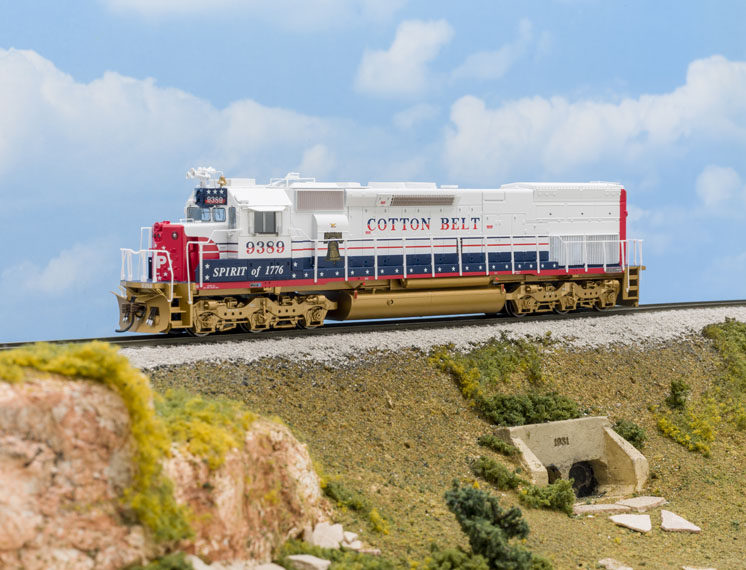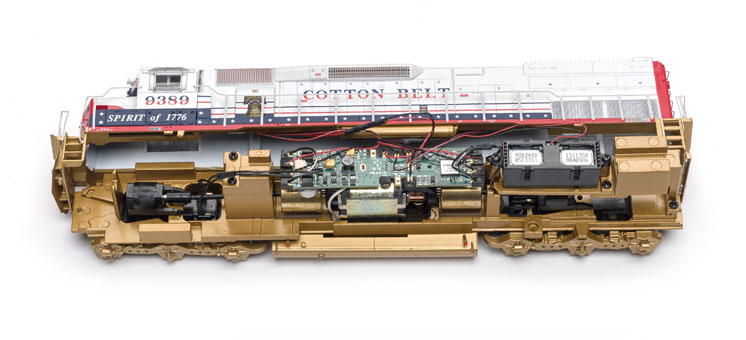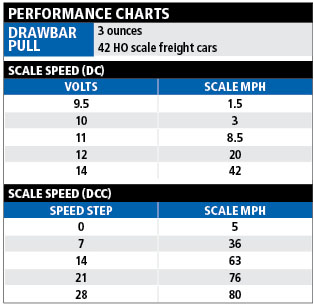Athearn Trains is launching an HO scale model of Electro-Motive Division’s SD45T-2 Tunnel Motor. Though it’s part of the manufacturer’s Ready-to-Roll line, the model comes equipped with features usually found on Athearn’s high-end Genesis-line products. The locomotive is available as a direct-current model or equipped with a dual-mode SoundTraxx Econami Digital Command Control sound decoder.
Prototype history. EMD built 247 tunnel motors between February 1972 and June 1975 for the Southern Pacific and its subsidiary St. Louis Southwestern (known as the Cotton Belt). The term “tunnel motor” refers to modifications made to EMD’s SD45-2’s cooling system to make it run better in tunnels and snowsheds. The air near the top of a tunnel can get hot and smoky, so tunnel motors have their air intake grills at walkway level, where the air is cooler and cleaner. On the prototype, you can see through the grills and out the other side; Athearn modified its rear truck’s gear tower so as not to obstruct this view on the model. The etched-metal grills are finely made and look great.
Some of these diesels would later operate on the Bessemer & Lake Erie; Duluth, Missabe & Iron Range; Kansas City Southern; and some short lines and locomotive leasing companies, including National Railway Equipment Co. (NREX). The rest would be acquired by Union Pacific when it merged with Southern Pacific in 1995. A few of these diesels are still running today.
A first look. All the dimensions that I checked matched those on drawings published in Model Railroader Cyclopedia: Vol. 2, Diesel Locomotives (Kalmbach Books, out of print). The size and placement of details like hand grabs, fans, radiators, dynamic brakes, and hood doors also matched drawings.
The paint on both our samples was smooth, even, and opaque. The tricky color placement on the Cotton Belt Bicentennial paint scheme, particularly the two-color hood lettering and the multi-color insignia, was spot on. The tiniest lettering on both models’ stencils and warning stickers was crisp and legible under magnification.
The sample in the SP “bloody nose” paint scheme bears a sticker on its box indicating it’s “Primed for Grime.” See a photo on page 4. According to the Athearn website, such models have faded base colors, “tattered and torn” heralds and lettering, and paint patches to match the prototypes. The “Southern Pacific” lettering on the locomotive’s long hood is distressed differently on each side.
All the blackened-metal wheels are driven, and all pick up power. On our samples, all were in gauge, according to our National Model Railroad Association standards gauge. The McHenry plastic knuckle couplers were likewise mounted at the correct height.
Road test. Since the model was equipped with a dual-mode decoder, which will run under both DC and DCC, I tested the models both ways. After ensuring both sample models ran identically, I performed most of my tests on the Cotton Belt model.
I ran the locomotive first under direct current. Sound decoders draw a lot of voltage, so when running under DC, I had to turn the power pack up to 6V before the locomotive responded by turning on the lights. The decoder played an authentic engine startup sound sequence when the throttle reached 7.5V. But the locomotive didn’t start moving until 9.5V, leaving a very small usable throttle range. At our power pack’s maximum voltage, 14V, the locomotive topped out at 42 mph, lower than the prototype’s top speed of 65 mph.
Under DCC, I had more control over the locomotive’s speed. The engine started out at 5 scale mph in speed step 1 and accelerated smoothly through the speed curve to reach 80 scale mph at speed step 28.
As a six-axle, long-wheelbase locomotive, the SD45T-2 isn’t intended for small layouts. It looks best going around broad curves. Nonetheless, the model is built to handle 18″ radius curves. It had no problem negotiating the 19″ radii and no. 4 turnouts on our Eagle Mountain layout.
Advanced consisting. Programming both our sample models’ DCC decoder addresses to match their cab numbers was a simple matter with our NCE Power Cab. Since we have two samples, I set up an advanced consist so the two could run together.
I decided to consist them to run back-to-back. Designating the Cotton Belt unit as the lead engine, I selected a consist address of 9 (the only common digit in both cab numbers) and programmed it into that locomotive’s Consist Address, CV19. To make the Southern Pacific unit run backward, I added 128 to the consist address of 9 and programmed a value of 137 into that engine’s CV19.
SoundTraxx’s Econami decoder uses five other CVs – 21, 22, 245, 246, and 247 – to let you customize how a consisted locomotive will respond to function keys and other commands. I checked the Econami decoder user manual (online at soundtraxx.com/manuals) and programmed CV21 and 22 so the bell and horn would work only on the lead engine, but the lights and dynamic brake would respond on both.
A great package. With its HO scale EMD SD45T-2 tunnel motor, Athearn blurs the line between its entry level and high-end locomotives. Etched metal and wire details, prototype-specific cabs and detail placement, and great sound are premium features I’d expect to see on a pricier model. Kudos to Athearn for putting them in a Ready-to-Roll package.
Manufacturer
Athearn Trains
1600 Forbes Way, Suite 120
Long Beach, CA 90810
athearn.com
Era: 1972 to present
Road names: St. Louis Southwestern (“Cotton Belt,” Bicentennial scheme, one number), Southern Pacific (bloody nose paint scheme, as delivered in four road numbers and with distressed lettering in one number), Montana Rail Link (fantasy scheme, three numbers), NREX (ex-SP patch-out and white, one number each), Southern Railway of British Columbia (fantasy scheme, one number).
Features
• All-wheel drive and electrical pickup
• DC model: 21-pin NEM decoder socket
• DCC model: SoundTraxx Econami dual-mode sound decoder
• Etched-metal details
• Five-pole motor with dual flywheels
• HT-C trucks with separately applied brake cylinders and speed recorders
• Light-emitting-diode lighting
• McHenry scale knuckle couplers
• Prototype-specific cab and other details
• Weight: 1 pound
















